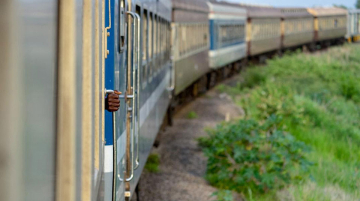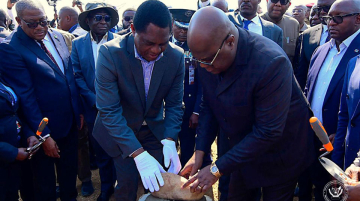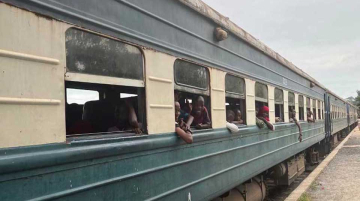
“You seem to have been working for many years for the TAZARA,” curious about the railway, I asked the old electrician.
“I’ve been working for this railway for 30 years.” He was repairing wires between carriages.
It was a rainy day. Gentle raindrops fell, covering the bustling capital city of Dar es Salaam, Tanzania. On my end-of-campus trip to Africa exploring railways and their interconnectedness of scenery and memory, I couldn’t help but reflect on the power dynamics in this vast land.
I opted for a ride on a boda – Africa’s usual urban transport mode. My unusual destination was the original terminus of the Tanzania – Zambia Railway, or TAZARA, renowned as China’s most iconic aid project in Africa. Approaching the terminus, everything seemed novel to me: dilapidated roads, overwhelming dust, as well as young boys capitalizing on traffic jams to tout snacks and water to drivers.

A strong feeling of familiarity, however, suddenly washed over me as I arrived. I was startled by the Socialist Realism building with Chinese characteristics: a dysfunctional clock hung high on the facade, walls and pillars made of monotonous beige bricks, reminiscent of railway stations in provincial capitals of 1970s Maoist China.
With an interior decoration exuding a vintage vibe rarely seen in its home country, a plastic board in the midway of stairs read – TAZARA: A Monument to China-Africa Friendship. Adjacent to it, a row of photos showcased the Chinese presence in Africa dating back to the 1960s. One particularly well-known photograph depicted young Chinese workers laying tracks hand in hand with their black friends, or African comrades.
“So, tell me your story. Chinese people want to hear about the TAZARA,” I kept asking. It’s common for an ordinary Chinese person to have heard about TAZARA, or African countries like Tanzania and Zambia thousands of miles away. Their names were even engraved into high school textbooks.
In the 1970s, China, then a country with limited resources helped nascent countries build a 1,860km railway without any preconditions, linking Tanzania’s Dar es Salaam to landlocked Zambia’s Kapiri Mposhi. The official agreement was signed in 1967, a few years after many Africans gained independence from European powers, with Tanzania in 1963 and Zambia in 1964. The construction itself took eight years and cost some 70 lives of Chinese workers and engineers.
“When I was in secondary school, I developed a strong fascination with roaring locomotives. I went to railway school and eventually became an electrician for the TAZARA.”
“So, you began working for the train in the 1990s, not in the 1970s.”
“Yes. But look at this.” He said, pointing to the first carriage parking at the end of the track, “This is the original car, manufactured in 1973.”
I crouched down and noticed the seal of the DFH-2 series diesel locomotives buried beneath layers of dust. Now I could recall more details from my personal readings – at least on post-colonial narratives.
At a moment when the West and the Soviet Union had rejected construction proposals from the newly independent African republics, the latter turned to China to accomplish this challenging mission.
China provided comprehensive machinery and personnel without added additional cost or interest on the loans it provided to build what would become one of Africa’s first international railways in the post-colonial era. This support came at a time when China itself was suffering from economic and social trauma from the Great Cultural Revolution, as well as geopolitical confrontation with both superpowers.

“It’s been 50 years. It’s in disrepair, isn’t it?”
As he focused on the cables, I wondered whether China’s motivation to build TAZARA was altruistic or some kind of Cold War geopolitical move. In declassified archives and diplomats’ memoirs, pages were saturated with an idealistic revolutionary spirit rooted in the concept of all-workers-of-the-world-unite. These sentiments were unfamiliar to today’s people.
However, from a perspective grounded in political reality, I couldn’t entirely dismiss the counterargument. During the Cold War, the Communist Chinese on the mainland sought support from African states as part of a larger effort to gain an advantage at the UN against its rivals in Taiwan, as well as against headwinds from rivals like the U.S. and the USSR. In this context, TAZARA could be seen as the springboard for China’s African engagement strategy that continues a half-century later to the present day.

“Yes, it is barely surviving,” the old electrician answered after a brief hiatus.
Later, I hustled my way into the railway’s offices and warehouses. Machines were rusted, fabrics got moth-eaten, and the paints had faded. It appeared that only a few people from both countries were actually aware of the complicated history behind this simple acronym.
“How much longer do you think it will continue to operate?”
“Well, it really depends on,” he exhaled, “You know, government, maintenance, and…”
“Just give me a number, please.”
“I’ll say 100 years,” the old electrician said with a grin.
A few moments later, hundreds of passengers flocked onto platforms and boarded carriages as the old electrician disappeared from sight. At exactly 4:00 p.m., I boarded the commuter train heading to Mwansa, a nearby city of Dar, where I encountered more: locals excited to see a Chinese person.
To me, it was fairly reminiscent to witness some internationalist legacies of a bygone era, which were rarely seen before as well as at present, serving as an alternative to another grand railway bearing the fate of a continent known as the Lunatic Express.

Officially Uganda Railway, dubbed as the Lunatic Express, built as a meter-gauge railway connecting the interiors of Uganda and the Indian Ocean port city of Mombasa of Kenya had a purpose: to safeguard African territories from potential colonization attempts by fellow European powers.
My journey began with TAZARA as an alternative, a remarkable but unique testament to the power dynamics associated with railway networks, reflecting on the words of Sir Charles Eliot in 1903, a Victorian commissioner of British East Africa:
“It is not uncommon for a country to build a railway, but it is uncommon for a railway to create a country.”
The role of railways in shaping modern Africa cannot be understated. Serving as crucial arteries of transportation, railways have played a paramount role in the colonization of the continent. A blend of imperialism, modernization, and colonization arrived en masse in Africa in the late 19th century. Militaries, settlers, indentured workers, and iron tracks formed the very foundation of the colonial structure, giving rise to institutions such as Christian churches, port authorities, telegraph bureaus, roads and railways, and as the commissioner put, ultimately the creation of modern countries.
Uganda Railway’s construction commenced in 1896 and by the end of May 1899, the rails had reached Nairobi where the railway headquarters was located. Between 1896 and 1901 at a cost of £5 million (equivalent to £650 million today) and at an expense of approximately 2,493 lives, the Lunatic Express gained its nomenclature from a combination of a fierce debate in the British Parliament, exorbitant capital investments, casualties caused by malaria and man-eating lions, plus a touch of orientalism.
The saying attributed to Sir Charles Eliot over a century ago still resonated today. Daniel Knowles, a contemporary British journalist from The Economist, traveled to Kenya to cover the Lunatic Express, a railway journey that epitomized contradictions. Despite the official 480-km 7-hour route from Nairobi to Mombasa, Daniel found himself spending a staggering 24 hours onboard. In his account, he described the train all reminded him of Britain – “not of the real, modern country but of a mythologized one.”
The waves of the Indian Ocean, guided by the monsoon, caressed the shore in a melodic rhythm. It was within this captivating coastal backdrop that my journey to trace the Lunatic Express and its new Chinese-made alternative commenced. Starting from Mombasa, a city deeply entrenched in colonial history, it was impossible to ignore the fatalistic allure of the coast. Standing prominently along the coastline was the remarkable Fort Jesus, a World Cultural Heritage site. Originally built by Portuguese sailors, fortified by Omanis mercenaries, and modified by English bureaucrats, it stood as a monument of colonial influence.
Not far from the fort laid the remnants of an old railway station, a poignant reminder of the recently abandoned line. Like the Oriental Express that crossed Europe and numerous other railways in the Victorian era, the Lunatic Express became synonymous with the pinnacle of European power.

By taking a minivan from the old station, I arrived at the new Chinese-made SGR station, situated in the suburb, officially known as Nairobi – Mombasa Standard-Gauge Railway (SGR).
As I glanced around, a surprising sense of familiarity as well as a touch of newness came to me, not reminiscent of the 1970s Maoist People’s Republic, but reminding me of today’s China. From the architectural designs and crew uniforms to the ticketing process, the entire setup bore striking similarities to the East Asian country.
An imposing bust of Admiral Zheng He, commemorating the first Chinese fleet’s arrival in East Africa in 1414 greeted me at the entrance to the platforms. The fleet cost extravagantly, seeking neither trade nor conquest, but seemingly for the grandeur of the Celestial Dynasty and the glamor of the emperor. I couldn’t help but pause, while Kenyans streamed past.
As punctual as the trains in China, the journey from Mombasa began precisely at 3:00 p.m. Opting for the second economy class, I found myself in the last carriage of the train, with Kenyan people napping, chatting, laughing, and having snacks, while watching mesmerizing Savanna landscape with its grasslands and African baobabs in motion. A thought emerged: What truly sets the SGR apart from the fleet of Zheng He, or TAZARA?

The SGR, the largest-ever infrastructure project in modern Kenya, emerged as a benchmark for the changing priorities of Chinese stakeholders. No longer focused on the dissemination of dynastical grandeur, or emancipation of all humankind, the Chinese approach now emphasized practicality and returns on investment.
In 2009, the Kenyan Government signed a memorandum of cooperation with the China Road and Bridge Corporation (CRBC), and in December 2014, the construction commenced following financing agreements signed by then Premier Li Keqiang signed financing agreements with East African leaders. The project received a total investment of $380 million, with 90% financed by China Exim Bank and 10% funded by Kenya Government which established a specialized custom tax fund for guarantee.
Three years later, in 2017, President Kenyatta, holding the national flag of Kenya, announced the opening of SGR, as the century-old British meter-gauge railway eventually ceased to operate in that same year.
However, amid the rise of new express, skepticism abounded. Today’s travelers can hardly ignore the presence of the Chinese language from the moment they embark, with slogans of giant state-owned infrastructure enterprises dominating the verbiage.
Under the Belt and Road Initiative, China has invested billions of dollars in Africa, sparking heated debates both internationally and domestically. Concerns over predatory lending and restructuring challenges circulated in the arenas of international meetings, columns of The Economist and The New York Times, and even to constant classroom discussions of my stint at Columbia University.
Simultaneously, significant capital outlays for overseas infrastructure projects fueled doubts among Chinese netizens, raising questions on whether these were white elephants to reimagine dynastical grandeur.
As the train journey continued, I retreated from my thoughts and immersed myself in the breathtaking sunset that graced the distant horizons – an ethereal display of nature’s beauty. When Daniel from The Economist gazed out of the old train, he felt a profound connection to “an older Africa.” However, as I looked out of the train window, I was pleasantly surprised to find a new world unfolding before my eyes.
I wrapped up my journey in Uganda where the Lunatic Express physically reached its end. As Nairobi kept expanding the SGR, Uganda was set to kick off its first SGR cooperating with Turkish firms. While power dynamics had been shaping modern Africa through various means and ends, it was great to learn, from this venture to three railways, that railways were no longer creating borders, but created by countries.
Zhang Haotian is a recent graduate of Columbia University’s School of International and Public Affairs. He took this amazing journey in Africa after graduation before taking on a new job in international finance.











